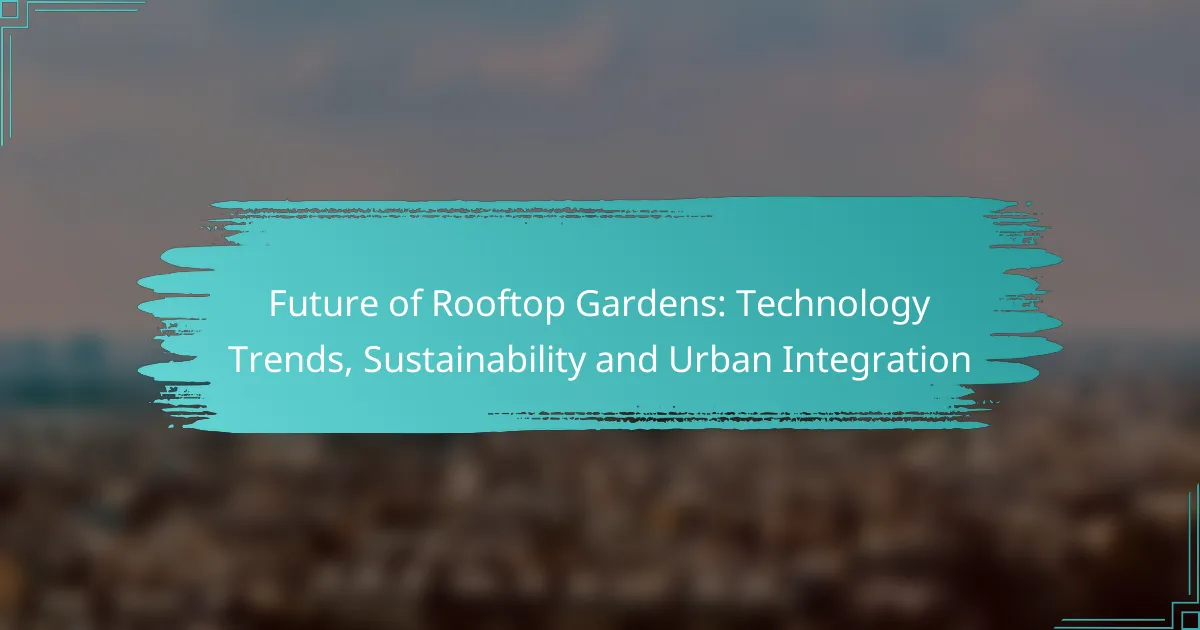The future of rooftop gardens is being shaped by technology trends that enhance sustainability and urban integration. These green spaces not only improve air quality and biodiversity but also contribute to energy efficiency, making them vital for urban living. Innovative solutions are emerging to optimize resource use, allowing city residents to enjoy the benefits of nature while minimizing environmental impact.
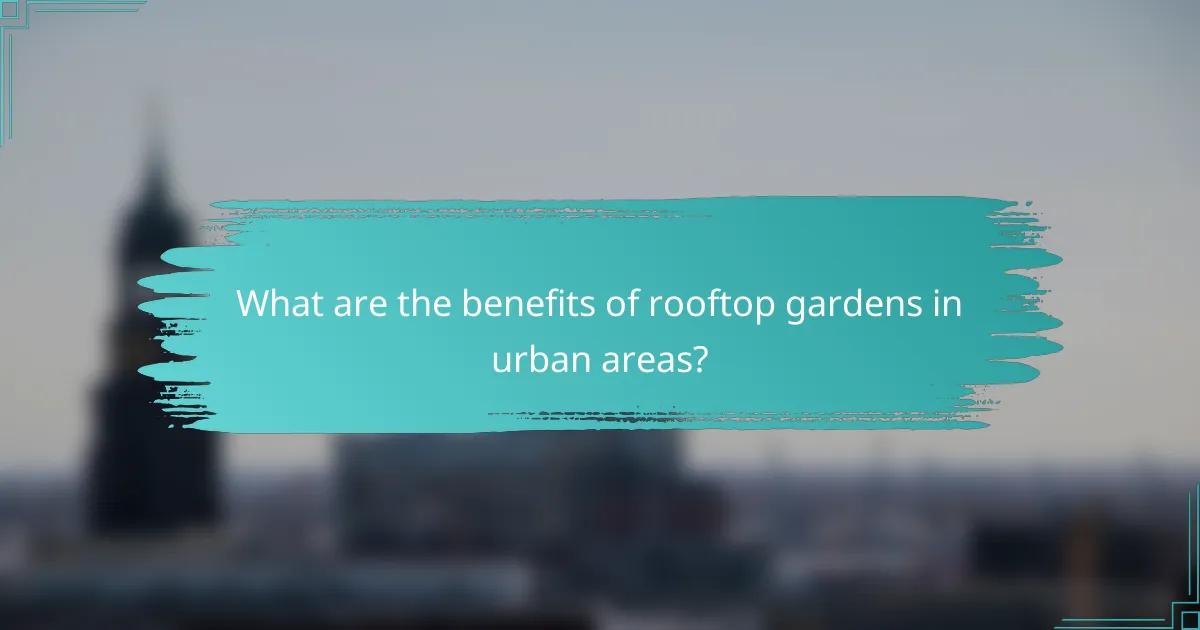
What are the benefits of rooftop gardens in urban areas?
Rooftop gardens offer numerous advantages in urban settings, including improved air quality, enhanced biodiversity, and energy efficiency. These green spaces not only contribute to environmental sustainability but also enhance the quality of life for city residents.
Improved air quality
Rooftop gardens play a significant role in improving air quality by filtering pollutants and absorbing carbon dioxide. Plants in these gardens can capture particulate matter and other harmful substances, leading to cleaner air in densely populated areas.
Incorporating a variety of plants can maximize air purification benefits. For instance, using native species can be particularly effective as they are adapted to local conditions and often require less maintenance.
Enhanced biodiversity
Rooftop gardens create vital habitats for various species, promoting biodiversity in urban environments. By providing food and shelter, these gardens attract pollinators like bees and butterflies, which are essential for ecosystem health.
Designing rooftop gardens with a mix of flowering plants, shrubs, and grasses can support a wider range of wildlife. This approach not only benefits local fauna but also contributes to the overall ecological balance in cities.
Energy efficiency
Rooftop gardens can significantly enhance energy efficiency in buildings by providing insulation. They help regulate indoor temperatures, reducing the need for heating in winter and cooling in summer, which can lower energy bills.
Studies suggest that green roofs can reduce energy consumption by up to 20-30%. Homeowners and businesses should consider the initial investment in a rooftop garden as a long-term savings strategy.
Stormwater management
Rooftop gardens are effective in managing stormwater by absorbing rainwater and reducing runoff. This helps prevent flooding and decreases the burden on urban drainage systems during heavy rainfall.
Implementing a green roof can retain a significant portion of rainfall, often around 60-80%, depending on the design and plant selection. This feature is particularly beneficial in cities prone to heavy storms and flooding.
Urban heat island mitigation
Rooftop gardens help mitigate the urban heat island effect by cooling the surrounding air through evapotranspiration. This process reduces the overall temperature in urban areas, making them more comfortable during hot weather.
By replacing traditional roofing materials with green roofs, cities can lower surface temperatures significantly, contributing to a more sustainable urban environment. This is especially important in regions experiencing extreme heat events.

How is technology transforming rooftop gardens?
Technology is significantly enhancing rooftop gardens by introducing innovative solutions that improve efficiency, sustainability, and productivity. These advancements allow urban dwellers to maximize their green spaces while minimizing resource consumption.
Smart irrigation systems
Smart irrigation systems utilize sensors and weather data to optimize water usage in rooftop gardens. By adjusting watering schedules based on real-time conditions, these systems can reduce water waste and ensure plants receive the right amount of moisture.
For example, a smart irrigation system can save up to 30% more water compared to traditional methods. Homeowners can install drip irrigation or automated sprinklers that respond to soil moisture levels, making maintenance easier and more efficient.
Automated maintenance tools
Automated maintenance tools, such as robotic lawn mowers and plant care drones, simplify the upkeep of rooftop gardens. These devices can perform tasks like mowing, pruning, and even pest control without requiring constant human intervention.
Investing in these tools can save time and labor costs, especially for larger rooftop gardens. However, it’s essential to choose equipment that is compatible with the specific plants and layout of the garden to avoid damage.
Vertical farming technologies
Vertical farming technologies maximize space by allowing plants to grow in stacked layers, making them ideal for rooftop gardens in urban areas. These systems often incorporate hydroponics or aeroponics, which use nutrient-rich water instead of soil.
By using vertical farming, gardeners can increase yield per square meter significantly, making it possible to grow a variety of crops in limited space. Additionally, these systems can be integrated with smart technology for monitoring growth conditions and optimizing plant health.
Sensor integration for plant health
Sensor integration for plant health involves using devices that monitor environmental factors like temperature, humidity, and soil pH. This data helps gardeners make informed decisions about watering, fertilization, and pest management.
For instance, soil moisture sensors can alert users when plants need water, preventing over- or under-watering. Utilizing these sensors can lead to healthier plants and more productive gardens, ultimately enhancing the sustainability of urban green spaces.
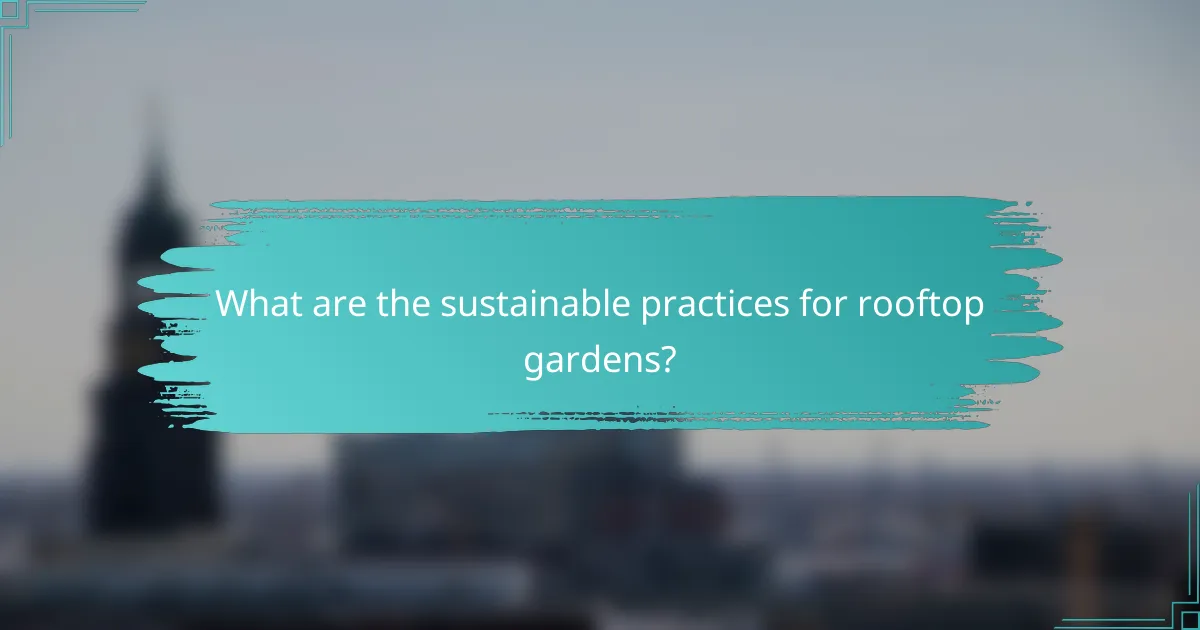
What are the sustainable practices for rooftop gardens?
Sustainable practices for rooftop gardens focus on minimizing environmental impact while maximizing benefits such as biodiversity and energy efficiency. These practices include using native plants, harvesting rainwater, maintaining soil health through composting, and utilizing solar energy.
Use of native plants
Incorporating native plants in rooftop gardens enhances sustainability by supporting local ecosystems and requiring less maintenance. These plants are adapted to the local climate, which means they typically need less water and are more resistant to pests.
When selecting native species, consider local flora that thrive in your region’s conditions. This can lead to reduced irrigation needs and lower overall garden upkeep.
Rainwater harvesting
Rainwater harvesting is an effective method for managing water resources in rooftop gardens. By collecting rainwater, gardeners can reduce reliance on municipal water systems and lower water bills.
Implementing a rainwater collection system involves installing gutters and storage tanks. Ensure the system complies with local regulations and is designed to filter and store water safely for irrigation purposes.
Composting and soil health
Composting is essential for maintaining soil health in rooftop gardens, as it enriches the soil with nutrients and improves its structure. Using kitchen scraps and yard waste for compost can significantly reduce landfill contributions.
To start composting, create a designated area with proper aeration and moisture control. Regularly turning the compost helps speed up decomposition, resulting in nutrient-rich soil that supports plant growth.
Solar energy utilization
Utilizing solar energy in rooftop gardens can enhance sustainability by reducing energy costs and reliance on fossil fuels. Solar panels can be installed to power garden lighting, irrigation systems, or even small appliances.
When considering solar energy, assess the available sunlight on your rooftop and the potential energy needs of your garden. Investing in solar technology can lead to long-term savings and a smaller carbon footprint.
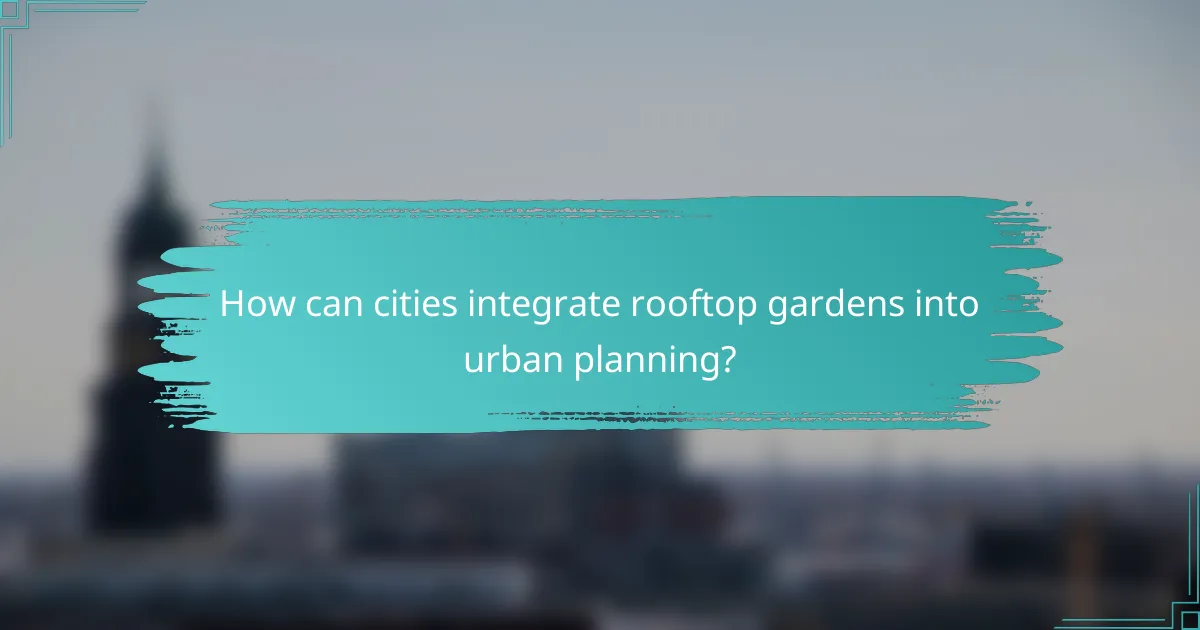
How can cities integrate rooftop gardens into urban planning?
Cities can effectively integrate rooftop gardens into urban planning by establishing supportive policies, fostering community involvement, and creating partnerships with local businesses. These strategies not only enhance urban aesthetics but also improve sustainability and biodiversity.
Policy incentives for developers
Implementing policy incentives can encourage developers to incorporate rooftop gardens into their projects. For instance, cities can offer tax breaks, density bonuses, or expedited permitting processes for buildings that include green roofs. These incentives can significantly lower the financial barriers associated with installing and maintaining rooftop gardens.
Additionally, municipalities can establish guidelines that promote green building standards, ensuring that developers meet specific sustainability criteria. Such regulations can help create a more uniform approach to urban greening efforts.
Community engagement initiatives
Engaging the community is crucial for the successful integration of rooftop gardens. Cities can organize workshops and informational sessions to educate residents about the benefits of green roofs, such as improved air quality and reduced urban heat. These initiatives can foster a sense of ownership and encourage local participation in gardening efforts.
Furthermore, involving community members in the design and maintenance of rooftop gardens can lead to more vibrant and well-utilized spaces. Creating volunteer programs or partnerships with local schools can enhance community ties and promote environmental stewardship.
Partnerships with local businesses
Forming partnerships with local businesses can provide additional resources and support for rooftop garden projects. Businesses can sponsor garden installations or contribute materials, while also benefiting from enhanced visibility and community goodwill. For example, a local café might collaborate with a rooftop garden to source fresh herbs and vegetables directly from the site.
Moreover, businesses can host events or workshops on the rooftop gardens, further integrating these green spaces into the urban fabric. This collaboration can create a win-win scenario, where both the community and local enterprises thrive through shared green initiatives.
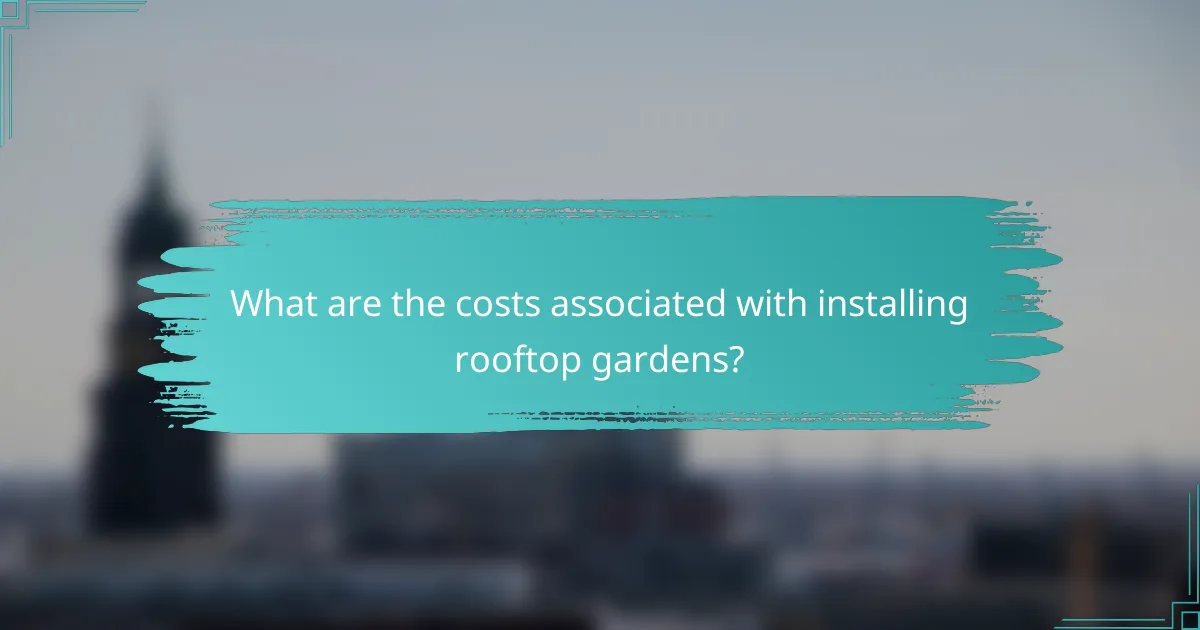
What are the costs associated with installing rooftop gardens?
The costs of installing rooftop gardens can vary widely based on factors such as size, design complexity, and materials used. Generally, homeowners and businesses can expect to invest anywhere from a few thousand to tens of thousands of dollars for a complete setup.
Initial Installation Costs
Initial installation costs for rooftop gardens typically include materials, labor, and design fees. Basic systems may start at around $15 to $30 per square foot, while more elaborate designs with advanced irrigation and drainage systems can exceed $50 per square foot. It’s essential to obtain multiple quotes from contractors to ensure competitive pricing.
Maintenance Expenses
Maintenance expenses for rooftop gardens can range from $100 to $500 annually, depending on the garden’s size and plant selection. Regular upkeep includes watering, weeding, and seasonal planting, which can be handled by the property owner or outsourced to landscaping services. Budgeting for maintenance is crucial to ensure the garden thrives over time.
Potential Financial Benefits
Investing in rooftop gardens can lead to long-term financial benefits, including reduced energy costs and increased property value. Studies suggest that green roofs can lower energy bills by up to 20% due to improved insulation. Additionally, properties with rooftop gardens may see a higher resale value, making them an attractive investment.
